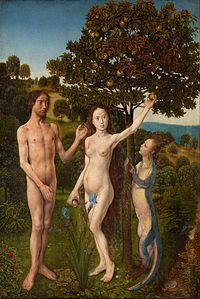
Summary
The Vienna Diptych or the Fall and Redemption of Man[1] is a religious diptych by the Flemish artist Hugo van der Goes depicting the fall of man on the left panel and the lamentation of Christ on the right panel. Painted in the second half of the 15th century, the diptych is housed in the Kunsthistorisches Museum, Vienna.[1] According to Wolfgang Kermer, who also described the work in detail in its condition in 1967, the diptych is unique in the history of diptych painting in terms of its subject matter (antithesis: Fall of Man / Redemption).[2]


The tempting Serpent is depicted as a bipedal salamander-like creature because it was assumed that the serpent could walk before God's curse compelled it to crawl and eat dust.[3] The human-headed Serpent was introduced into art in the late 13th century.[3] Subsequent Renaissance artists generally abandoned the depiction of Serpent as a human-headed creature.[3]
The reverse side of the left panel has an image of Saint Genevieve painted on it.[4] The reverse side of the right panel bears traces of a coat of arms, consisting of a shield with a black eagle and two supporters, of which only the feet survived.[4] The coat of arms was painted in the 17th century and indicates possible House of Habsburg ownership of the diptych.[4]
See also edit
References edit
- ^ a b "Goes, Hugo van der – Vienna Diptych". Van Pelt Library. Retrieved 1 February 2015.
- ^ Wolfgang Kermer: Studien zum Diptychon in der sakralen Malerei: von den Anfängen bis zur Mitte des sechzehnten Jahrhunderts; mit einem Katalog. Düsseldorf: Dr. Stehle, 1967 [PhD diss., Eberhard Karls Universität Tübingen, 1966], 2 vols., 1:151–154 (iconographic interpretation), 2:136–137 (with bibliography), ill. 175, 176.
- ^ a b c Koch, Robert A. (1965). "The Salamander in Van der Goes' Garden of Eden". Journal of the Warburg and Courtauld Institutes. 28 (1): 323–326 [323]. doi:10.2307/750680. JSTOR 750680. S2CID 195042873.
- ^ a b c Trowbridge, Mark (2011). "Sin and Redemption in Late-Medieval Art and Theater: The Magdalen as Role Model in Hugo van der Goes's Vienna Diptych". In Sarah Blick; Laura Deborah Gelfand (eds.). Push Me, Pull You: Imaginative, Emotional, Physical, and Spatial Interaction in Late Medieval and Renaissance Art. Brill. pp. 415–445 [444]. doi:10.1163/9789004215139_013. ISBN 978-9004205734.


